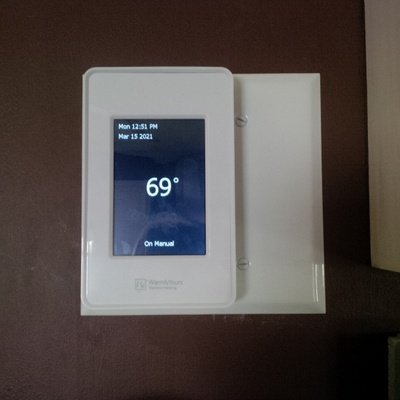UDG4-4999-WY reviewed by Thomas G. of Rhinebeck, NY
Works Great! Some Installation Issues.
I bought this thermostat because it was the only one I could find where I could program in my pre-existing non-standard 5k ohm floor sensor resistance. The price was 3x that of a good and capable Honeywell unit, but I needed one to work with my sensor. Installation was somewhat difficult as it is designed to have the stiff solid copper wires from the house attached directly to the thermostat. Other brands have flexible twisted wire leads attached to the T-stat that are then "wire nutted" to the house leads. As the module on the back of the Tstat is nearly as tall as the opening in the electric box, wires could not be inserted into the ends of the Tstat as I believe it was designed for. I had to take the snap-on cover off the back and run the leads to the terminals in the other direction. Cover could not then be reattached (not really an issue). Again, due to the size of the module I had to drill a hole for the sensor wire as the existing hole routed the senor wire over the metal edge of the electric box. In my case, my original Tstat was installed in a double wide box, so that was good. I don't think it would have been possible to install this Tstat in a single wide box. With all that behind me, the unit is working well and I am happy with it.

The other brands' flexible wire connections actually fill the box with unneeded wire. Most wall-mounted line voltage devices, like light switches, use the same type of screw connections. This results in less wiring in the box and less space taken up by wirenuts. This leads to cooler temperatures inside the wall box. These devices are designed by the manufacturer to fit into a single space box. The snap-on connector in the back is designed to be removed during the wire attachment and then re-installed when done. This is shown on our video showing how to replace the old unit with the new. This device may not fit as well in a very shallow single gang box, but then again, it is designed to fit into a normal or deep single gang box.
